

How X-rays Work" X-rays are basically the same thing as visible light rays. Both are wavelike forms of electromagnetic energy carried by particles called photons (see How Light Works for details). Ablation. Ablation is removal of material from the surface of an object by vaporization, chipping, or other erosive processes. Examples of ablative materials are described below, and include spacecraft material for ascent and atmospheric reentry, ice and snow in glaciology, biological tissues in medicine, and passive fire protection materials.
Nuclear Fission Basics. How does fission work? How do nuclear fusion and nuclear fission work. Compton Scattering. In Compton scattering, an incoming photon of energy E (shown in black) undergoes an elastic collision with a weakly bound (assumed free) outer-shell electron (shown in blue). Electrons, photons, and the photo-electric effect. We're now starting to talk about quantum mechanics, the physics of the very small.
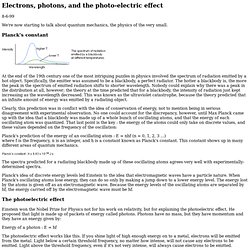
Planck's constant At the end of the 19th century one of the most intriguing puzzles in physics involved the spectrum of radiation emitted by a hot object. Specifically, the emitter was assumed to be a blackbody, a perfect radiator. The hotter a blackbody is, the more the peak in the spectrum of emitted radiation shifts to shorter wavelength. Nobody could explain why there was a peak in the distribution at all, however; the theory at the time predicted that for a blackbody, the intensity of radiation just kept increasing as the wavelength decreased. Clearly, this prediction was in conflict with the idea of conservation of energy, not to mention being in serious disagreement with experimental observation.
Planck's prediction of the energy of an oscillating atom : E = nhf (n = 0, 1, 2, 3 ...) where f is the frequency, n is an integer, and h is a constant known as Planck's constant. Plasmas. Plasmas exist in a wide range of settings and varieties.
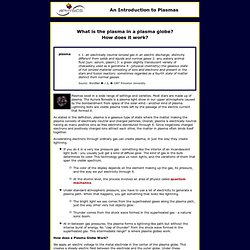
Most stars are made up of plasma. The Aurora Borealis is a plasma light show in our upper atmosphere caused by the bombardment from space of the solar wind - another kind of plasma. Lightning bolts are visible plasma trails left by the passage of the electric current that formed it. As stated in the definition, plasma is a gaseous type of state where the matter making the plasma consists of electrically neutral and charged particles. Overall, plasma is electrically neutral having as many positive ions as free electrons distributed through it.
Accelerating electrons through ordinary gas can create plasma, in just the way they create lightning. If you do it in a very low pressure gas - something like the interior of an incandescent light bulb - you usually just get a kind of diffuse glow. How does a Plasma Globe Work? New Cold Fusion Evidence Reignites Hot Debate. 25 March 2009—On Monday, scientists at the American Chemical Society (ACS) meeting in Salt Lake City announced a series of experimental results that they argue confirms controversial ”cold fusion” claims.
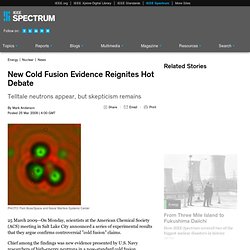
Chief among the findings was new evidence presented by U.S. Navy researchers of high-energy neutrons in a now-standard cold fusion experimental setup—electrodes connected to a power source, immersed in a solution containing both palladium and ”heavy water.” If confirmed, the result would add support to the idea that reactions like the nuclear fire that lights up the sun might somehow be tamed for the tabletop. But even cold fusion’s proponents admit that they have no clear explanation why their nuclear infernos are so weak as to be scarcely noticeable in a beaker. National Ignition Facility. The National Ignition Facility, located at Lawrence Livermore National Laboratory.
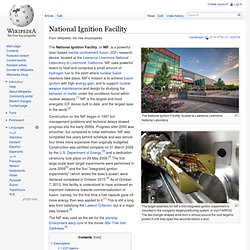
The target assembly for NIF's first integrated ignition experiment is mounted in the cryogenic target positioning system, or cryoTARPOS. The two triangle-shaped arms form a shroud around the cold target to protect it until they open five seconds before a shot. The National Ignition Facility, or NIF, is a powerful laser-based inertial confinement fusion (ICF) research device, located at the Lawrence Livermore National Laboratory in Livermore, California. NIF uses powerful lasers to heat and compress a small amount of hydrogen fuel to the point where nuclear fusion reactions take place. NIF's mission is to achieve fusion ignition with high energy gain, and to support nuclear weapon maintenance and design by studying the behavior of matter under the conditions found within nuclear weapons.[1] NIF is the largest and most energetic ICF device built to date, and the largest laser in the world.[2] ICF basics[edit]
National Ignition Facility & Photon Science - Bringing Star Power to Earth. Scientists plan to ignite tiny man-made star. How scientists brought the power of the Sun to Earth « Goodheart's Extreme Science. How scientists brought the power of the Sun to Earth Posted by Steven Goodheart on February 1, 2010 · 6 Comments The super-amplified light impacts the target area with an intensity and ferocity only found in the hottest places in the universe.
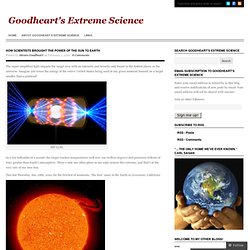
Imagine 500 times the energy of the entire United States being used at any given moment focused on a target smaller than a pinhead! In a few billionths of a second, the target reaches temperatures well over 100 million degrees and pressures billions of time greater than Earth’s atmosphere. There’s only one other place in our solar system this extreme, and that’s at the very core of our own Sun. Fusion power. 106, 085004 (2011): Demonstration of Ignition Radiation Temperatures in Indirect-Drive Inertial Confinement Fusion Hohlraums. Big science in a small space.
The National Ignition Facility (NIF) at Lawrence Livermore in California was designed with a specific goal: to use high-powered lasers to ignite a fusion reaction that releases more energy than the one million joules needed to start it.
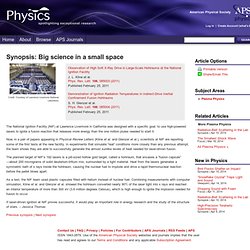
Now, in a pair of papers appearing in Physical Review Letters (Kline et al. and Glenzer et al.), scientists at NIF are reporting some of the first tests at the new facility. In experiments that simulate “real” conditions more closely than any previous attempt, the team shows they are able to successfully generate the almost sunlike levels of heat needed for laser-driven fusion. Nuclear Fusion : WNA. (Updated February 2014) Fusion power offers the prospect of an almost inexhaustible source of energy for future generations, but it also presents so far insurmountable scientific and engineering challenges.
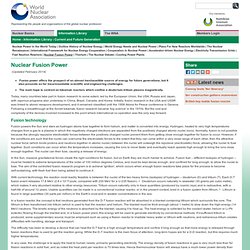
The main hope is centred on tokamak reactors which confine a deuterium-tritium plasma magnetically. Today, many countries take part in fusion research to some extent, led by the European Union, the USA, Russia and Japan, with vigorous programs also underway in China, Brazil, Canada, and Korea. Initially, fusion research in the USA and USSR was linked to atomic weapons development, and it remained classified until the 1958 Atoms for Peace conference in Geneva.